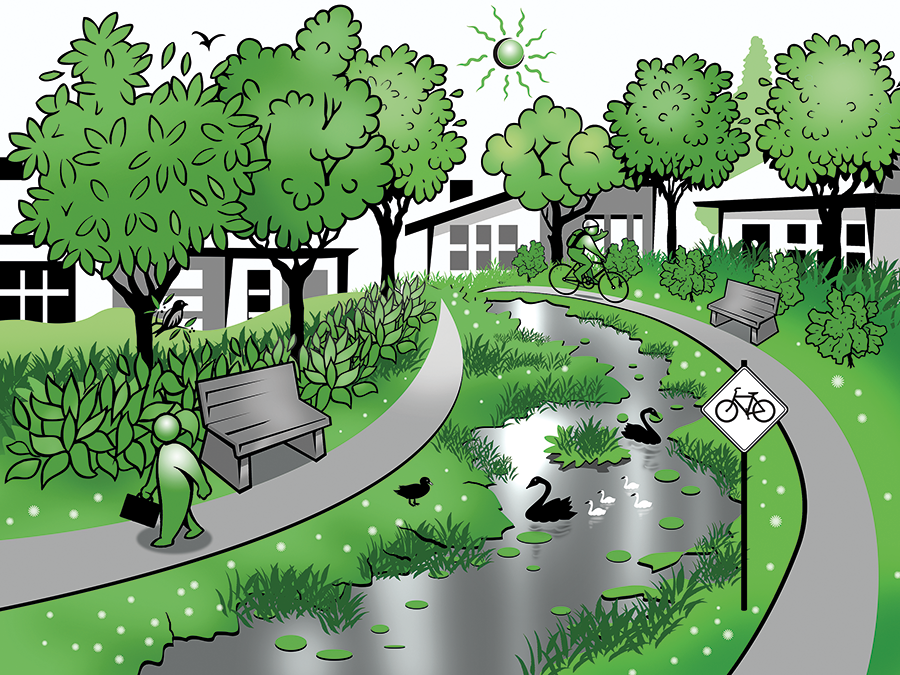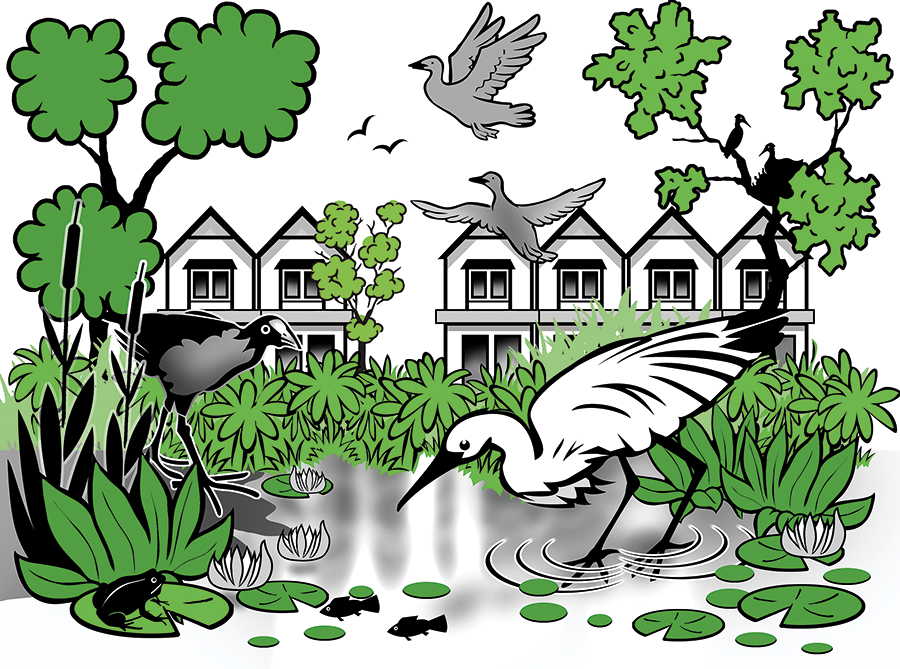# 
Ecology
Subdivisions can retain and enhance ecology by responding to, protecting and improving the biodiversity within a development plan or subdivision site.
# Why do subdivisions need to retain and enhance ecology?
Although the existing conditions on any new greenfield subdivision will vary, the subdivision process should aim to retain and enhance the natural environment as much as possible. This will not only provide a positive environmental outcome but offer significant liveability benefits to residents and capture the economic benefit of healthy ecosystems.
These benefits are known as ecosystem services. Key ecosystem services include: Habitat for wildlife, urban temperature regulation, runoff mitigation, food supply and recreational and aesthetic benefits.
The cooling effects from trees has been shown to reduce the need to cool homes and provide comfort in public places, even during extreme heat.
Enhanced ecology begins with the subdivision design process. By assessing existing conditions, recognising existing natural features and biodiversity, the design process can then seek to protect and improve them.
Natural features include existing trees, areas of native vegetation (that might include grasses and shrubs, not just trees), waterways and wetlands, wildlife habitat such as rocky outcrops, logs and fallen timber. In some case man-made features, such as dams, might also be considered valuable for biodiversity.
 Retaining and enhancing the natural environment in subdivision design offers significant liveability and economic benefits through ecosystem services.
Retaining and enhancing the natural environment in subdivision design offers significant liveability and economic benefits through ecosystem services.
# Benefits of retained and enhanced ecology
Developers can take advantage of:
- Enhanced market appeal of the subdivision to prospective purchasers
- The economic benefit of ecosystem services
- Demonstrating best practice environmental management and creating climate resilient neighbourhoods
A new resident can expect:
- Improved comfort with cooler surrounds
- A healthy urban environment that supports local wildlife
- The opportunity to interact with nature in your immediate neighbourhood
“ Thoughtful planning of subdivisions at the early design stage can reduce the impact of the development on the natural environment, enabling opportunities to preserve and enhance local ecology. This approach can support conditions that will maintain and even improve the ecology throughout the life of the subdivision. ”
# Canopy cover
Large canopy trees are a key contributor to urban cooling, however, also benefit the overall biodiversity value of the site.
Canopy cover principles include:
- Providing lots with areas and dimensions that enable the retention and establishment of trees
- Promoting early delivery of medium and large trees
Public realm targets for projected canopy of 30% will ensure that trees can establish effectively within road reserves and open spaces. This includes ensuring integrated water management provides trees with adequate access to water, particularly as they are establishing.
This first step to enabling large canopy trees is to design around existing mature trees and implementing tree protection measures during construction.
Accelerating the process of planting medium and large trees, will ensure that even the first residents will have improved amenity and access to significant greening.
# Biodiversity conservation
Biodiversity conservation focuses on ensuring that existing flora, fauna and habitat is protected within and in close proximity to the subdivision. It also considers how biodiversity will be maintained through the life of the subdivision.
Biodiversity conservation principles include:
- Protecting, retaining and enhancing native vegetation and habitat over the long term
- Promoting a best practice and risk management approach to the management of biodiversity assets which aims to avoid or minimise environmental degradation and hazards
- Ensuring consistency with any native vegetation precinct plan
Effective biodiversity conservation requires an effective implementation pathway including maintenance plans, biodiversity management plan and adequate tree protection zones through the construction.
Developing and implementing programs to increase resident involvement in biodiversity asset maintenance will also support biodiversity conservation.
# Enhance biodiversity value
Subdivision design and construction needs to do more than protect existing biodiversity. It should also outline key strategies to increasing or enhancing biodiversity value.
Enhancement of biodiversity value principles include:
- Promoting the creation of habitat corridors and movement of flora and fauna
- Avoiding the planting and spread of environmental weeds
- Promoting the delivery of any vegetation offsets locally to the subdivision
Strategies to enhance biodiversity include using native species in landscaping, layering of plantings to create diversity of habitat and novel habitat creation such as hollow creation for birds and mammals.
These strategies combine to create high species diversity, connections between key ecological assets and ensure that streets, parkland and environmental buffers to waterways are optimised to deliver the full range of ecosystem services including recreation, food production and place value - the key to liveability.
 Using native plants, diverse plant layers, and creating new habitats for wildlife enhances biodiversity, connects ecosystems, and improves amenity and recreation value.
Using native plants, diverse plant layers, and creating new habitats for wildlife enhances biodiversity, connects ecosystems, and improves amenity and recreation value.
# Case study
| Location | Warralily Armstrong Creek, City of Greater Geelong (opens new window) |
| Site Area | 380 ha |
| Number of Dwellings | 4,000 |
| Development Type | Residential + community infrastructure |
| Year / Status | 2010 (launch) / Ongoing |
| Sustainability Accreditation | EnviroDevelopment |
| Key Stakeholders | Armstrong Creek Development Corp. (Development) Newland Developers (Project Management) Australian Ecosystems (Landscaping & Restoration) Ecology & Heritage Partners (Ecological Assessments) Flora Victoria (Ecological Restoration) |
| Key Features | - 82 hectares of parklands and waterways. - 3.36 hectares of native grassland re-establishments. - Three dedicated conservation zones. - Wetlands and creek line restoration of Armstrong Creek. - Planting over 1 million plants in the creek corridor. - Preservation and incorporation of remnant vegetation including the relocation of stags within the creek and wetland areas. |
DISCLAIMER: This Fact Sheet has been created for general information purposes only. While the Fact Sheet has been created with all due care, no warranty is given as to its suitability for any particular purpose and users should obtain their own advice relevant to their situation and specific needs. MAV or any party authorised by MAV to reproduce the Fact Sheet is not responsible for the accuracy, currency or reliability of the Fact Sheet and accepts no liability for any damage, losses whether direct or indirect, claims or expenses howsoever arising from any party who may rely on its contents.
The Council Alliance of a Sustainable Built Environment (CASBE) maintains these Sustainable Design fact sheets on behalf of our member councils. (opens new window)
CASBE is supported by the Municipal Association of Victoria (MAV).
Copyright © Municipal Association of Victoria 2025